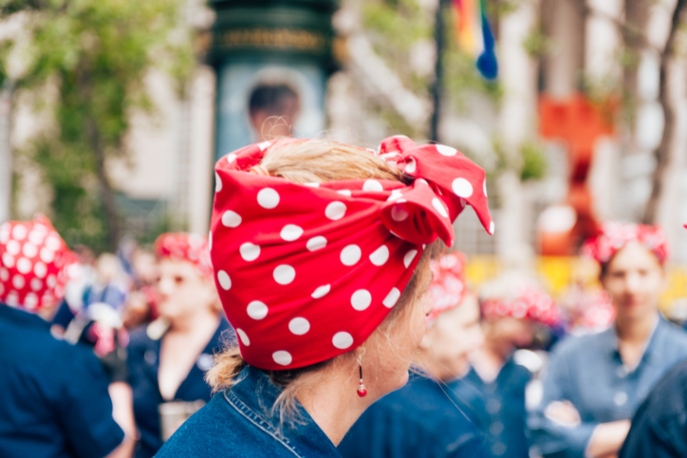Photo Credit: Tommy Wu
During World War II, many men were away from home to serve the war effort. This left a very large deficit in the American workforce and an ever-increasing need to accommodate domestic manufacturing demand. PBS noted that, “In early 1942, the Bureau of Labor Statistics predicted a big problem: Unless action was taken, a shortage of six million workers would bring the country’s productivity to a halt by the end of 1943.” For this first time, the U.S. government decided to launch a campaign to recruit a previously ignored working population: women. On this Rosie the Riveter Day, we’re investigating how Rosie impacted popular culture, the workforce, and broader past and contemporary American society.
Perhaps the most famous part of this propaganda campaign was Rosie the Riveter. Today’s most well-known image of her, the “We Can Do It!” poster by Pittsburgh artist J. Howard Miller, depicts her as a Westinghouse Electric and Manufacturing Company employee in a red and white bandana and blue denim coveralls. A different, more popular then but lesser known now Rockwell image, portrayed Rosie with a rivet gun on her lap and resting her feet on Mein Kampf (signifying superiority over Nazi ideology). She represented an American vision of the patriotic woman tackling previously male-only workspaces with strength, assertiveness, and bravado. This image, along with 1943 song “Rosie the Riveter”, propelled the American archetype into stardom.
Indeed, there was a significant transformation in the workplace and American life as the nation knew it. The number of employed women went from 10.8 million in 1941 to 18 million in 1944, with women taking up more and more space in factories and shipyards as machinists, assemblers, sheet metal workers, welders, and yes, riveters.
This is not to say that these workplaces were any sort of utopia for working women. Women were still paid less than their male counterparts, and it was expected that they would leave their positions once the soldiers returned home. If not, they faced consequences like harassment and demotions. Also, the image of Rosie represented the white American housewife stepping up to the place, erasing the many women of color who worked these jobs from public consciousness. Bitter Fruit: African American Women in World War II author Dr. Maureen Honey said, “The war represented this incredible opportunity, but Black women really had to rally and fight for the opportunity to even be considered. Many employers held out, attempting to only hire white women or white men, until they were forced to do otherwise.”
In addition to combatting the patriarchy embedded in the male labor force, each and every “Rosie” had to contend with a broader American culture encouraging them through ads, fashion trends, and public discourse to abandon their jobs and newly found financial autonomy to return to the feminine housewife ideal. While this cultural imagining of these women did not reflect the reality of this new workforce (as many of the “Rosie’s” were not housewives, but were already working and used the war as an opportunity to move from low-paying clerical, domestic, and waitressing jobs to higher-paying, “masculine” factory jobs), it did attempt to shame women into closing the door to opportunity to maintain the patriarchal power structure.
However, this campaign’s lasting power was that it demonstrated to so many women across the United States that they hold the potential to be more than a stereotype. The Miller poster gained traction over the years, and in the 1990s became one of the most recognizable images in feminist circles. For the American audience today, the poster transcends the 1940s wartime era and has begun to represent a universally positive thought: girls and women can do anything they set their minds to.
It is this very spirit that we hope to see workplaces embody this Rosie the Riveter Day. We hope that Rosie can serve as an inspiration to you to champion women in leadership, fight for pay equity, provide paths for upward mobility to employees of all genders, and ensure all of your “Rosie’s” have a seat at the table to help shape their future and the future of all women workers.
RALIANCE is a trusted adviser for organizations committed to building cultures that are safe, equitable, and respectful. RALIANCE offers unparalleled expertise in serving survivors of sexual harassment, misconduct, and abuse which drives our mission to help organizations across sectors create inclusive environments for all. For more information, please visit www.RALIANCE.org.

